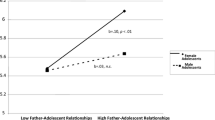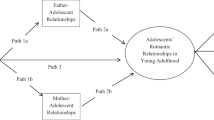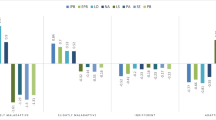Abstract
While researchers have documented the possible effects of divorce on children's interpersonal relationships with significant others (e.g., parents, siblings, peers), research efforts examining the role of grandparents within these children's social networks are limited. For the present study, 588 late adolescent college students (266 males, 322 females) completed the Network of Relationships Inventory (W. Furman and D. Buhrmester [1985] “Children's Perceptions of the Personal Relationships in Their Social Network,” Developmental Psychology, Vol. 21, pp. 1016–1024) and frequency of contact estimates on each available biological grandparent. One hundred sixty-eight students were from families in which their biological parents had been divorced for more than two years. The remaining late adolescents were from intact families (i.e., biological parents still married). As hypothesized, late adolescent grandchildren from divorced families indicated less satisfactory relationships with paternal grandparents. In addition, granddaughters from divorced families indicated poorer relationships with parental grandparents when contrasted to grand-daughters in intact families and grandsons from divorced families. However, visible and phone contact with grandparents played a major role in sustaining relationships with grandparents for grandchildren from divorced families. Granddaughters, in general, also reported stronger relations with maternal grandmothers, regardless of group status. Explanations are offered for these results, as well as suggestions for future research.
Similar content being viewed by others
References
Baranowski, M. (1982). Grandparent-adolescent relations: Beyond the nuclear family.Adolescence 17: 575–584.
Baron, R., and Kenny, D. (1986). The moderator-mediator variable distinction in social psychological research: Conceptual, strategic, and statistical considerations.J. Person. Social Psychol. 51: 1173–1182.
Berndt, T. (1985). Prosocial behavior between friends in middle childhood and adolescence.J. Adolesc. 5: 307–313.
Bryant, B. (1985). The neighborhood walk: Sources of support in middle childhood.Monogr. Society Res. Child Develop. 50(3, Series No. 210).
Cherlin, A. J., and Furstenberg, F. F. (1986).The New American Grandparent. Basic Books, New York.
Creasey, G. L., and Kobelewski, P. (1991). Adolescent grandchildren's relationships with maternal and paternal grandmothers and grandfathers.J. Adolesc. 14: 373–387.
Emery, R., Hetherington, E. M., and DiLalla, L. (1984). Divorce, children, and social policy. In Stevenson, H., and Siegal, A. (eds.),Child development and social policy. University of Chicago Press, Chicago.
Feinman, S., and Robert D. (1985, April). Infants' interaction with grandparents, relatives, and adult Mends of the family. In Myers, B. J., and Feinman, S. (chairs),Grandparents and Very Young Children. Symposium presented at the biennial meeting of the Society for Research in Child Development, Toronto, Canada.
Furman, W. (1989). The development of children's social networks. In Belle, D. (ed.),Children's Social Networks and Social Supports. Wiley, New York.
Furman, W., and Buhrmester, D. (1985). Children's perceptions of the personal relationships in their social networks.Develop. Psychol. 21: 1016–1024.
Furstenberg, F. (1988). Child care after divorce and remarriage. In Hetherington, E., and Alasteh, J. (eds.),Impact of Divorce, Single Parenting, and Stepparenting on Children. Erlbaum, Hillsdale, NJ.
Gilligan, C. (1982).In a Different Voice: Psychological Theory and Women's Development. Harvard University Press, Cambridge, MA.
Gladstone, J. W. (1988). Perceived changes in grandmother-grandchild relations following a child's separation or divorce.The Gerontologist 28: 66–72.
Glick, P., and Lin, S. (1987). Remarriage after divorce: Recent changes and demographic variations.Social Perspect. 30: 162–179.
Hagestad, G. O. (1985). Continuity and connectedness. In Bengston, V. L., and Robertson, J. (eds.),Grandparenthood: Traditional and Emergent Perspectives. Sage, Beverly Hills, CA.
Hagestad, G. O., and Speicher, J. L. (1981, April).Grandparents and family influence: Views of three generations. Paper presented at the meeting of the Society for Research in Child Development, Boston.
Hess, R., and Camara, K. (1979). Post-divorce family relationships as mediating factors in the consequence of divorce upon children.J. Social Issues 25: 79–96.
Hetherington, E. M. (1989). Coping with family transitions: Winners, losers, and survivors.Child Develop. 60: 1–14.
Hetherington, E., Hagen, M., and Anderson, E. (1989). Marital transitions: A child's perspective.Am. Psychol. 44: 303–312.
Johnson, C., and Barer, B. (1987). Marital instability and the changing kinship networks of grandparents.The Gerontologist 27: 330–335.
Kornhaber, A., and Woodward, K. L. (1981).Grandparent/Grandchild: The Vital Connection. Anchor Press, Garden City, NY.
Myers, B. J., Jarvis, P. A., and Creasey, G. L. (1987). Infant's behavior with their mother and grandmothers.Infant Behav. Develop. 10: 245–259.
Robertson, J. F. (1975). Interaction in three generation families, parents as mediators: Toward a theoretical perspective.Int. J. Aging Human Develop. 6: 103–110.
Rosenthal, C. (1985). Kinkeeping in the familial division of labor.J. Marriage Family. 49:965–974.
Schaffer, H., and Emerson, P. (1964). The development of social attachments in infancy. Monogr. Society Res. Child Develop.
Sroufe, L. (1983). Infant-caregiver attachment and patterns of adaptation in preschool: The roots of maladaptation. In Perlmutter, M. (ed.),Minnesota Symposia on Child Psychology (Vol. 16). Erlbaum, Hillsdale, NJ.
Thompson, R., Tinsley, B., Scalora, M., and Parke, R. (1989). Grandparent's visitation rights: Legalizing the ties that bind.Am. Psychol. 44: 1217–1222.
Wallerstein, J., and Kelly, J. (1980).Surviving the breakup: How children and parents cope with divorce. Basic, New York.
Author information
Authors and Affiliations
Additional information
Received Ph.D. in developmental psychology from Virginia Commonwealth University. Current research interests include the study of intergenerational relationships, and the development of coping skills throughout the life span.
Rights and permissions
About this article
Cite this article
Creasey, G.L. The association between divorce and late adolescent grandchildren's relations with grandparents. J Youth Adolescence 22, 513–529 (1993). https://doi.org/10.1007/BF01537713
Received:
Accepted:
Issue Date:
DOI: https://doi.org/10.1007/BF01537713




